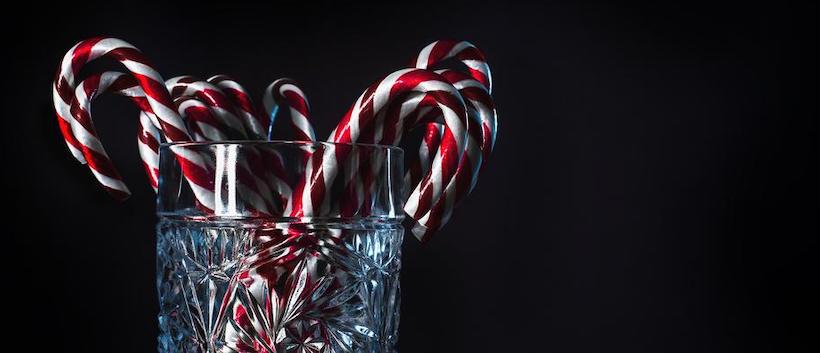Let's face it: candy is a hit at any time of year. But when December 1st rolls around each year, our family's thoughts quite naturally turn to that stalwart of the Christmas season: candy canes.
In some ways, candy canes require no introduction. Is there anyone around today who doesn't recognize the tell-tale sight of this straight red and white pencil-sized candy, with or without its signature top hook?
But the history of candy canes is far more colorful and imaginative than even your taste buds could dream up. So circle your chairs' round, grab yourself a minty treat, and ponder with us just why it is we love to welcome in the Christmas season with candy canes!

To hear the National Confectioners Association (NCA) tell it, in December, there is only one type of candy on nearly everyone's mind: candy canes.
Candy canes are the hands-down best-selling candy every December, and the NCA's explanation is simple: people love to decorate their Christmas trees with colorful red and white twisted treats.
So just what is in these confections that have made them such an enduring hit?
Is there a secret ingredient? Is it their size? Is it something about how you eat them?
Let's take a closer look taste!
The National Confectioners Association reports that the recipe for the classic candy cane is surprisingly simple.
There are only four ingredients in the traditional Christmas candy cane:
What isn't so simple is how candy canes are made. The NCA says that quite a lot of machinery is needed to mass-produce sufficient quantities of candy canes to decorate every family's Christmas trees!
To make candy canes, sugar and corn syrup are first mixed in a large kettle using a technique called "vacuum cooking."
The National American Association of Candy Technologists describes vacuum cooking as a reliable alternative to open-fire cooking. Essentially, a vacuum extracts excess moisture to produce reliable hard candies free from issues with sugar crystallization.
After the vacuum cooking process is complete, the candy base is emptied onto a confectioner's table to cool. There, peppermint is added along with starch. This locks in the mint flavor as well as keeps the mixture from sticking.
The resulting mixture is kneaded and sent first to a puller and then a batch roller.
Up until this point, the candy mixture is still pure white. So next, the red stripes are added, and the whole batch returns to the batch roller. After that, the candy passes through sizing wheels and into a twister that creates the signature variegated white & red pattern so recognizable around the world today.
The next-to-last step is when the candy canes are cut and packaged in plastic. The final step is when the now-packaged, cooling candy canes are sent to a crooker machine to install the hook-like shape at the top (the part that makes these candies obvious candidates for Christmas tree decorations).
In 2012, a chef in Geneva, Switzerland, set out to break a world record for creating the world's largest candy cane. As the World Record Academy reports, this candy cane measured 51 feet and contained 900 pounds of sugar.
A candy cane this size could easily topple even the most massive Christmas trees. Thankfully, most candy canes are quite a bit smaller and more comfortable to hang (and to eat!).
The most common size of candy cane, according to Made How: How Products Are Made, is a six-inch-long, 0.25-inch wide rod with a curved hook at one end.
However, as Made How also points out, there are a great many departures from this "standard" size. Candy canes today may be mini-length (two-inch long), extra-large-length (12-inch long), standard width (0.25-inch), extra-thick width (one-inch), or any other variant a candy-maker has dreamt up.
What's most impressive, though, are the variations in flavoring and recipes in candy canes today. From sugar-free and special diets (kosher, gluten-free, vegan) to alternate flavors (watermelon, green apple, chocolate), candy canes are evolving along with our other holiday traditions.
Even the most casual internet search reveals this is clearly a matter of personal taste!
Unbroken, broken, hook first, straight end first, licked or crunched, all bets are off when it comes to eating a candy cane.
However, Carly Schildhaus, the public relations manager for the National Confectioners Association, tells us that a mere 28 percent of cane-fans favor starting to eat a candy cane at the curved end. The remaining 72 percent wholeheartedly endorse starting at the straight end and working your way up.

National Day Calendar tells us, National Candy Cane Day is celebrated each year on the day after Christmas, December 26th.
But when was the first candy cane made? Who do we have to thank for this enduringly popular treat?
As it turns out – and you can see from this post – the origin and history of candy canes are pretty murky. However, that doesn't hurt their appeal – an estimated 1.76 billion candy canes are produced in the United States annually.
According to history.com, the first candy cane may have made its appearance right around 1670 in the town of Cologne, Germany.
An enterprising choirmaster-turned-candymaker is apocryphally credited with the invention. In the legend, the choirmaster was at a loss for how to keep unruly children's choir members quiet during lengthy Christmas church services.
So he created the hooked candy – ostensibly an easy-to-hold form for even the youngest singers – to help keep them occupied and quiet during sermons! Some versions of the story go on to say the choirmaster chose the hook shape to convince churchgoers the candies were appropriate in church because they looked like a shepherd's staff.
An author and historian named Susan Benjamin tells history.com that what is factually accurate and verifiable about this story is the popularity of a treat called "pulled sugars." That historic hard candy – essentially the modern candy cane without the hook and red stripe – during the 17th century in Europe.
Candy canes made their first documented appearance in what is now the state of Ohio in the United States as early as 1837, again by way of Germany. This time, it was a German/Swedish immigrant named August Imgard who decorated his holiday tree with treats that looked much like today's candy canes.
Imgard is now widely credited with launching the enduring tradition of hanging candy canes on holiday trees, even though some accounts of his holiday decorations say the canes were brown sugar cookies instead!
However, these earliest American candy canes may not have been white and red or even peppermint-flavored. That wouldn't happen until around the beginning of the 20th century when modern manufacturing processes made modifications to the popular treat both easier and faster, as Smithsonian Magazine explains.

As WhyChristmas found out, the earliest iteration of the Keller Machine was invented in 1952 by Father Gregory Harding Keller.
Keller was an ordained Catholic priest, and the brother-in-law to then up-and-coming candy maker and entrepreneur Bob McCormack.
Bob had launched his candy-making business in 1919. Unfortunately, pre-machine, Bob was having a hard time manufacturing sufficient quantities of candy canes to keep up with demand. Before the Keller, bending a candy cane was a surprisingly dexterous and challenging manual endeavor.
This early machine was designed to make it easier to make the stick part of the candy cane. In 1957, Father Keller added another feature - a hook maker!
Father Keller's invention quite literally put his brother's business, Bob's Candies, on the map. It launched the candy cane into the mass market, nearly eliminating breakage and ensuring families all over the world could become introduced to the tradition of hanging candy canes on Christmas trees (and eating the spoils after Christmas was over).
Today, candy canes are a universal staple in holiday traditions worldwide.
USA Today reports that a whopping 90 percent of yearly candy cane sales come between the end of Thanksgiving and the start of Christmas. The second week of December is the highest sales volume week for this tasty candy. (Could people be decorating their trees then?)
As well, USA Today states that candy canes have become a trendy addition to other holiday-themed sales items, from ready-made hot cocoa and cookies to chapstick and candles.

Questions about candy canes? Hopefully, I have answers.
The Fact Site reports that the average five-inch long, 0.25-inch wide candy cane contains about 50 calories and has no cholesterol or fat.
While many people – religious or otherwise – enjoy the story about the candy cane's origins as a symbol of Jesus and Christianity, the truth of that history is more uncertain.
I'll leave it with this: Father Keller was undoubtedly a Catholic priest and kicked the candy's popularity into high gear with the Keller Machine. Whether a choirmaster bribed young parishioners with hard confectionaries in 1670 is lost to history, in my opinion.
Various colorful theories exist about why the candy cane has its hook.
Considering that the earliest ancestors of candy canes were neither curved nor red and white, it is likely most of these theories would not stand up under intense scrutiny. (But they are fun to theorize about!)
One of the most popular candy cane curve theories dates back to the candy cane's reported invention in Germany in 1670. This theory links the hook to the shepherd's crook from the Bible. WhyChristmas points out the shepherds that visited the baby Jesus held these crooks during their visit.
Another popular theory held forth by many Christian traditions says that when you turn a candy cane upside down, it forms the letter J for Jesus. Whether that comparison is appropriate is one thing, but some folks have taken it that way. In 2018, an elementary school principal in the state of Nebraska made national news headlines for banning candy canes in school because of the Christian association.
The earliest candy canes were flavored with simple sugar. Today's multitude of candy cane colors and flavors – including but not limited to peppermint or wintergreen – only came along around the start of the 20th century. Peppermint was the first known flavoring, so usually, when you're thinking about potential benefits, you're thinking about peppermint.
Peppermint's active ingredient is the popular cooling agent menthol, which today is added to many over-the-counter internal, topical, and oral remedies to treat or alleviate a variety of health issues.
Interestingly, Medical News Today reports that peppermint is a known remedy for stomach troubles because it has the potential to calm spasming stomach muscles and improve bile flow while also reducing pain, bloating, and gas.
As one research study pointed out, peppermint's known anti-spasmodic properties mean it could also be useful to treat some symptoms of irritable bowel syndrome (IBS). To that end, Science Daily reported on research study results that peppermint could block pain sensation in the colon caused by IBS.
As the Penn State Hershey Medical Center states, peppermint is a calming and numbing agent with cooling properties. It also has known anti-bacterial, anti-viral, anti-fungal properties along with its analgesic (pain-relieving) and anti-spasmodic impact.
This one? It might be true.

So, the truth is we just don't know a ton about the origins of the candy cane. What is certain is that the fun, straight sugar stick evolves to the powerhouse of holiday hard candy that is the red and white curved candy cane.
What is for certain? They look good on my tree. I'm going to add a few more to mine... and probably eat one, too.